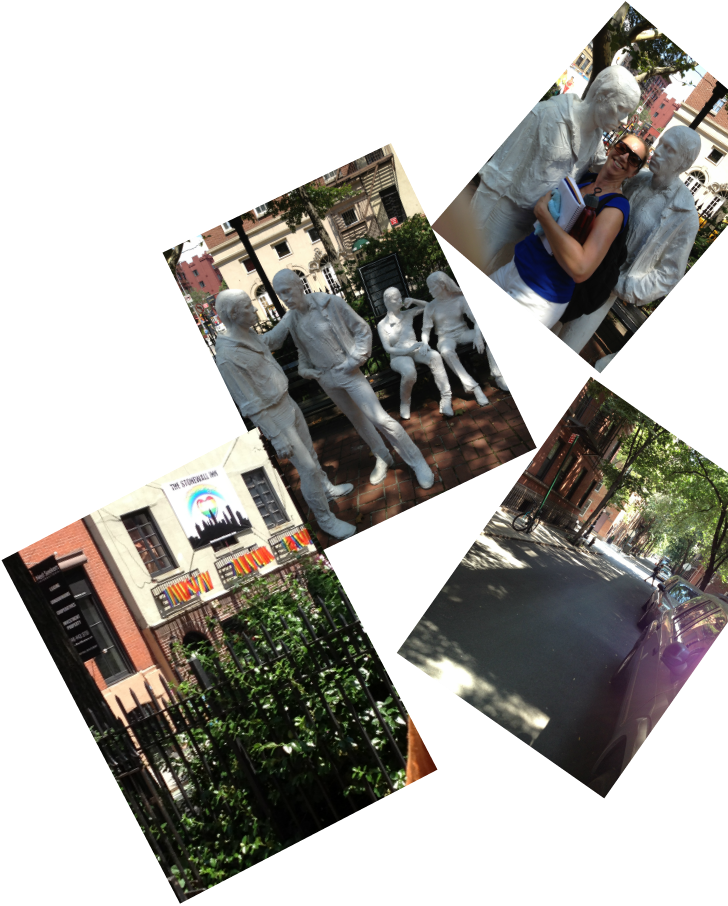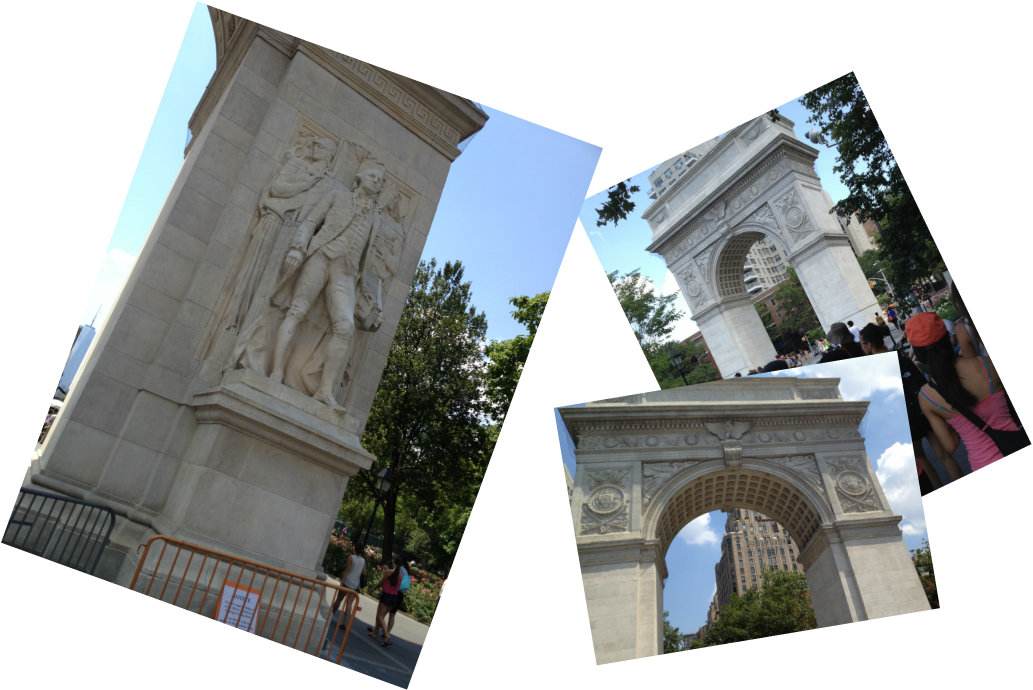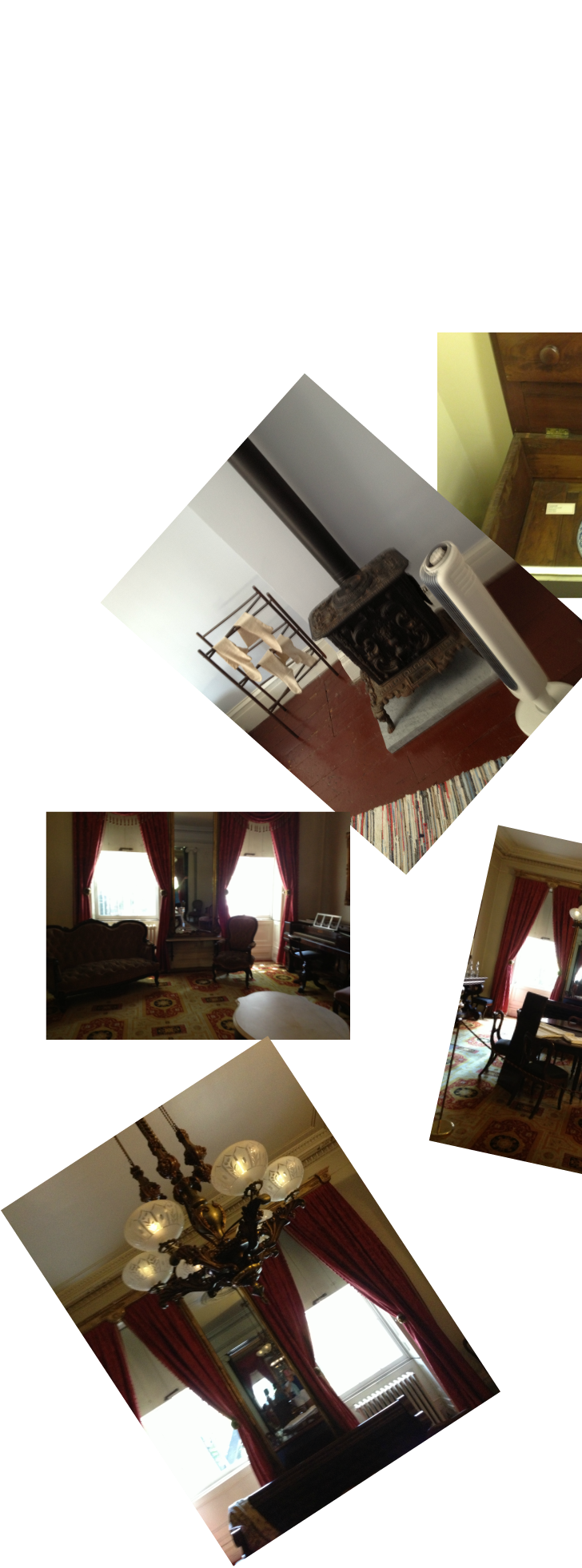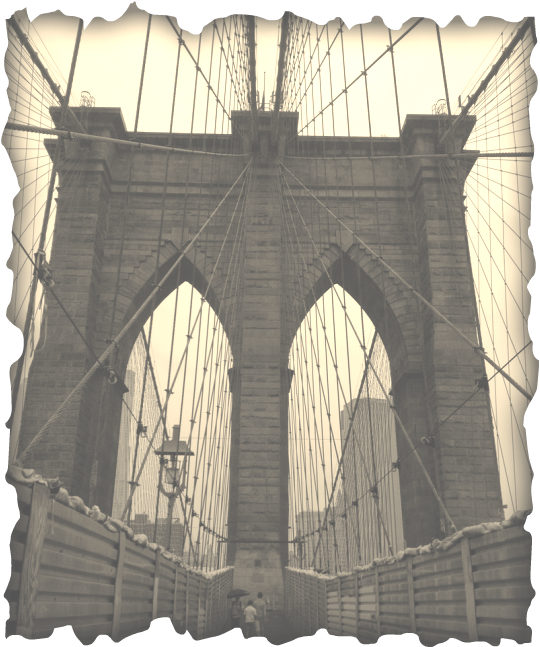Today was 93* HOT! We visited the three villages in Manhattan; The East Village, The West Village and Greenwich village. Greenwich Village is the area housing Washington Square and New York University: Greenwich Villages Christopher St is the heart of Manhattans gay community, it is known as the largest gay community in the country (Blue Guide, p 130).
The Stonewall Tavern is an icon in the village, it is here the infamous Stonewall riots took place on June/28 /1969 (Blue Guide, p. 130). The gay community usually met police presence with peace on this day they had had enough with the brutality they had endured, a riot broke out; the police were outnumbered and barricaded themselves in the Stonewall Tavern. Gay pride parades notably take place toward the end of June each year. Christopher Street park, perpendicular with the Stonewall Tavern portrays statues of gay men and lesbian woman.
The gay community has been chastised since the beginning of time.; being gay is frowned upon in most cultures, leaving both lesbians and gays to hide who they are and what defines them. Homosexuals have been burned alive, drowned and beaten; these attacks were not based on a person’s skin color but on sexual choice. The Stonewall Riot told the community and the law that the gay community was there to stay and was to be respected.
The Stonewall Tavern is an icon in the village, it is here the infamous Stonewall riots took place on June/28 /1969 (Blue Guide, p. 130). The gay community usually met police presence with peace on this day they had had enough with the brutality they had endured, a riot broke out; the police were outnumbered and barricaded themselves in the Stonewall Tavern. Gay pride parades notably take place toward the end of June each year. Christopher Street park, perpendicular with the Stonewall Tavern portrays statues of gay men and lesbian woman.
The gay community has been chastised since the beginning of time.; being gay is frowned upon in most cultures, leaving both lesbians and gays to hide who they are and what defines them. Homosexuals have been burned alive, drowned and beaten; these attacks were not based on a person’s skin color but on sexual choice. The Stonewall Riot told the community and the law that the gay community was there to stay and was to be respected.
The above pictures show the entrance into Washington Square Park the marble entrance way was designed by Sanford White and redesigned by Henry James in Marble. Facing the arch on the left is a Washington at war on the right is a Washington in peaceful times as a leader.
The park has an interesting history; Potters Field according to the Blue Guide began in the square, Potters Field (http://en.wikipedia.org/wiki/Hart_Island,_New_York) today is the largest tax paying mass grave site in the world, run by The Department of Corrections and located on Hart Island (http://hartisland.net/) : an uninhabited Island; prison laborers perform mass burials daily on the island of the unknown dead.
In the 1950s Robert Moses, who is most known for his bridges and highway projects wanted to build a road through, over or under Washington Square and was eventually defeated.
While in the park today the movie "Elementary" was being filmed by the sprinkler pool: we were allowed to stand in designated areas only and were told to be quiet by the film crew. this made for a difficult visit in the park.
We walked down McDougal and third the " Bohemian heart of the village" past 127 McDougal, Eve Cotchaver's first lesbian bar; past Cafe' Wha were Bob Dillon and many other famous artists have played; and onto Merchants House.
Merchants house was built by Joseph Brewster and purchased by Seabury Tredwell and his wife Eliza along with their seven children at the time of purchase in 1835; their eighth child was born in the house. Approximately ten years after purchase the area became a less fashionable place to live; the Treadwell's continued to live in the home until the 1933 with the death of Gertrude the youngest child. Our guide taught; in 1936, three years after Gertrude's death the site became a museum saved by a cousin George Chapman; the site is also considered to be a place were the most apparitions have been witnessed.
The Tredwell's , strict protestants only hired Roman Catholic servants causing much unrest in the household; this was an era of strict religion and Protestants and Catholics did not get along. The servants earned one dollar a week and were given one afternoon off per week. This caused much unrest in the household because it was presumed the servants were going to church. The servants were usually of Irish descent. It is speculated that this was due to the potato famine, the reason for the Irish coming over to send money to the family back home; also they tended not t to marry immediately.
Our guide continued with explaining why husband and wife had separate bedrooms; in these times if a family had money husband and wives had separate bedrooms because when a woman gave birth she did so at home, when a child became ill the mother nursed the child to health in her room,: when the woman had house guests they prepped themselves in her room (females only); this is because proper etiquette dictated certain behaviors are not to be displayed with in the homes parlor.
In the early 1800s woman were expected to always wear there corsets which explains why many woman would order there breakfast and lunch trays to their bedroom. Proper etiquette dictated that woman police themselves in way of ceremonial callings. The woman were given business cards with the hours and days that they were home; others would come to socialize should the woman refuse the visitor proper etiquette dictated the woman must pay a visit to the one refused within one week.
The home wore a number of different styles: revival style with the columns separating the front and rear parlors: revival offers a symmetrical look, meaning the two rooms mirrored each other. The front parlor's furnishings were of Rokoko style.
The family room was located in the basement; and so was the coal. For the servant to stay warm she collected the coal in the basement and brought it to the fourth flour, ninety steps up and ninety steps down. The family rooms ceiling was about eight feet high the rest of the house was twelve feet high. Dinner, schoolwork, play was all done in the family room.
The museum ordered a paint analysis done and is the only area in the house that may have original color of the walls. The museum is under construction now were we witnessed workers in the kitchen. The kitchen had a hearth with a cook stove in it for bread; water was delivered to them until the reservoir opened in 1842.
The park has an interesting history; Potters Field according to the Blue Guide began in the square, Potters Field (http://en.wikipedia.org/wiki/Hart_Island,_New_York) today is the largest tax paying mass grave site in the world, run by The Department of Corrections and located on Hart Island (http://hartisland.net/) : an uninhabited Island; prison laborers perform mass burials daily on the island of the unknown dead.
In the 1950s Robert Moses, who is most known for his bridges and highway projects wanted to build a road through, over or under Washington Square and was eventually defeated.
While in the park today the movie "Elementary" was being filmed by the sprinkler pool: we were allowed to stand in designated areas only and were told to be quiet by the film crew. this made for a difficult visit in the park.
We walked down McDougal and third the " Bohemian heart of the village" past 127 McDougal, Eve Cotchaver's first lesbian bar; past Cafe' Wha were Bob Dillon and many other famous artists have played; and onto Merchants House.
Merchants house was built by Joseph Brewster and purchased by Seabury Tredwell and his wife Eliza along with their seven children at the time of purchase in 1835; their eighth child was born in the house. Approximately ten years after purchase the area became a less fashionable place to live; the Treadwell's continued to live in the home until the 1933 with the death of Gertrude the youngest child. Our guide taught; in 1936, three years after Gertrude's death the site became a museum saved by a cousin George Chapman; the site is also considered to be a place were the most apparitions have been witnessed.
The Tredwell's , strict protestants only hired Roman Catholic servants causing much unrest in the household; this was an era of strict religion and Protestants and Catholics did not get along. The servants earned one dollar a week and were given one afternoon off per week. This caused much unrest in the household because it was presumed the servants were going to church. The servants were usually of Irish descent. It is speculated that this was due to the potato famine, the reason for the Irish coming over to send money to the family back home; also they tended not t to marry immediately.
Our guide continued with explaining why husband and wife had separate bedrooms; in these times if a family had money husband and wives had separate bedrooms because when a woman gave birth she did so at home, when a child became ill the mother nursed the child to health in her room,: when the woman had house guests they prepped themselves in her room (females only); this is because proper etiquette dictated certain behaviors are not to be displayed with in the homes parlor.
In the early 1800s woman were expected to always wear there corsets which explains why many woman would order there breakfast and lunch trays to their bedroom. Proper etiquette dictated that woman police themselves in way of ceremonial callings. The woman were given business cards with the hours and days that they were home; others would come to socialize should the woman refuse the visitor proper etiquette dictated the woman must pay a visit to the one refused within one week.
The home wore a number of different styles: revival style with the columns separating the front and rear parlors: revival offers a symmetrical look, meaning the two rooms mirrored each other. The front parlor's furnishings were of Rokoko style.
The family room was located in the basement; and so was the coal. For the servant to stay warm she collected the coal in the basement and brought it to the fourth flour, ninety steps up and ninety steps down. The family rooms ceiling was about eight feet high the rest of the house was twelve feet high. Dinner, schoolwork, play was all done in the family room.
The museum ordered a paint analysis done and is the only area in the house that may have original color of the walls. The museum is under construction now were we witnessed workers in the kitchen. The kitchen had a hearth with a cook stove in it for bread; water was delivered to them until the reservoir opened in 1842.
After a much needed lunch break we traveled to the Museum of reclaimed Urban Space. This is a museum created to teach the history of the squatter homes and how the neighborhood reclaimed itself. There is a lot of controversy here; let me start with my own belief, people should work, earn a living and pay their way in society. There are many affordable opportunities to get an education in New York, sometimes very bright people find a way to beat the system, I believe the squatters who won ( talked about in the following and the video presented) and not unlike Bill our tour guide represents the bright, uneducated squatter.
The Museum of Unclaimed Urban Space, located between Avenue C and Tenth Street, known as C Squat Building, is one of eleven buildings occupied legally by the squatters and now termed as homesteads by the city. The city let these areas go to waste, many buildings where abandoned by the owners due to the high crime rate and the cities inability to control it; Alphabet City was an absolute drug infested wasteland and uncontrolled by the fifth precinct.
Bill, an overgrown anarchist, explained, the cities inability to control the extreme crime rate caused many to believe the city was causing it: IE: per Bill "the city paid hoodlums to torch buildings, neighborhoods where expendable": this is the typical Lower East Side mind set of the uneducated anarchists belief.
The neighborhood was a drug infested slum in the 1970s, 1980s and most of the 1990s, filled with the worst human behavior influences; lack of responsibility and lack of ethics created many consequences we saw today in this community. Very unfortunately and only through the culture of the community Bill, at this time, is the only link to the history of the area. Bill gives the Molloy student the opportunity to experience the history of this unique area in person.
In the late 1970s, many buildings in NYC where abandoned by landlords due to the high crime rate. People in these areas were very poor and could not afford to move nor could they hire an attorney to help: buildings were crumbling around them, crime rates were very high and the city lost control. The people of the neighborhood took sledge hammers and began to smash each brick, each piece of cement eventually became sand and the people created gardens. the gardens represent the communities liberation from drugs and violence while cresting a formation of alliance to one another.
The gardens are land protected by the parks department, managed by the Green Thumbs program and maintained by the neighborhood. In the cultivation of destruction to construction a re-purposing movement began and is known today as " Environmental Sustainability".
The people of the Lower East Side are strong believers in recycling, we see this in the aluminium cans transposed into art which are imitating barbed wire and the garbage cans labeled for recycling throughout the city.
The Museum of Unclaimed Urban Space, located between Avenue C and Tenth Street, known as C Squat Building, is one of eleven buildings occupied legally by the squatters and now termed as homesteads by the city. The city let these areas go to waste, many buildings where abandoned by the owners due to the high crime rate and the cities inability to control it; Alphabet City was an absolute drug infested wasteland and uncontrolled by the fifth precinct.
Bill, an overgrown anarchist, explained, the cities inability to control the extreme crime rate caused many to believe the city was causing it: IE: per Bill "the city paid hoodlums to torch buildings, neighborhoods where expendable": this is the typical Lower East Side mind set of the uneducated anarchists belief.
The neighborhood was a drug infested slum in the 1970s, 1980s and most of the 1990s, filled with the worst human behavior influences; lack of responsibility and lack of ethics created many consequences we saw today in this community. Very unfortunately and only through the culture of the community Bill, at this time, is the only link to the history of the area. Bill gives the Molloy student the opportunity to experience the history of this unique area in person.
In the late 1970s, many buildings in NYC where abandoned by landlords due to the high crime rate. People in these areas were very poor and could not afford to move nor could they hire an attorney to help: buildings were crumbling around them, crime rates were very high and the city lost control. The people of the neighborhood took sledge hammers and began to smash each brick, each piece of cement eventually became sand and the people created gardens. the gardens represent the communities liberation from drugs and violence while cresting a formation of alliance to one another.
The gardens are land protected by the parks department, managed by the Green Thumbs program and maintained by the neighborhood. In the cultivation of destruction to construction a re-purposing movement began and is known today as " Environmental Sustainability".
The people of the Lower East Side are strong believers in recycling, we see this in the aluminium cans transposed into art which are imitating barbed wire and the garbage cans labeled for recycling throughout the city.



